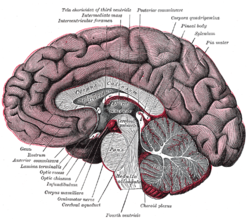Corpus Callosum
| Corpus callosum | |
|---|---|

Corpus callosum from above. (Anterior portion is at the top of the image.)
|
|

Median sagittal section of brain (person faces to the left). Corpus callosum visible at center, in light gray
|
|
| Identifiers | |
| MeSH | A08.186.211.730.885.362 |
| NeuroNames | hier-173 |
| NeuroLex ID | Corpus callosum |
| TA | A14.1.09.241 |
| FMA | 86464 |
|
Anatomical terms of neuroanatomy
[]
|
|
The corpus callosum (/ˈkɔːrpəs kəˈloʊsəm/; Latin for "tough body"), also known as the callosal commissure, is a wide, flat bundle of neural fibers about 10 cm long beneath the cortex in the eutherian brain at the longitudinal fissure. It connects the left and right cerebral hemispheres and facilitates interhemispheric communication. It is the largest white matter structure in the brain, consisting of 200–250 million contralateral axonal projections.
The posterior (back) portion of the corpus callosum is called the splenium; the anterior (front) is called the genu (or "knee"); between the two is the truncus, or "body", of the corpus callosum. The part between the body and the splenium is often markedly narrowed and thus referred to as the "isthmus". The rostrum is the part of the corpus callosum that projects posteriorly and inferiorly from the anteriormost genu, as can be seen on the sagittal image of the brain displayed on the right. The rostrum is so named for its resemblance to a bird's beak.
...
Wikipedia
